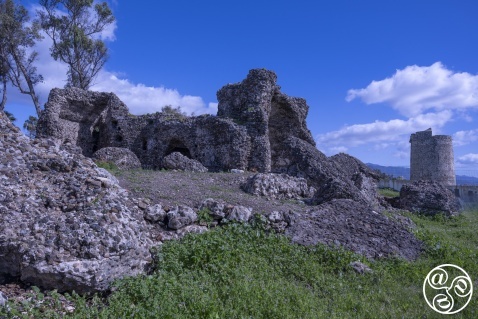
16th-century watchtower, named after nearby Roman baths, once warned locals of pirates and invasions. © Michelle Chaplow |
|
La Torre de las Bóvedas
This is a defensive watchtower from the XVI century. It takes its name from the
This is a defensive watchtower from the XVI century. It takes its name from the Roman baths, which are about 50 metres to the west. It is one of a chain of towers along the coast built at that time to warn the locals of pirates and possible Moorish invasions from North Africa.
It is a truncated cone, 8.20 metres in diameter at the base and over 13 metres high. It is slightly conical, but less so than the others, and leads to a larger terrace, perhaps to house larger artillery. On top of the solid base there is an upper part consisting of a chamber and a roof. The inner chamber has an entrance on the north-east side, 6.75m above the ground, and a small opening on the south side. An internal staircase leads to the roof, which has a raised parapet on the north-east side, with some preserved elements of the machicolations above the doorway.
It is built of stone, with the use of brick only in some elements, such as the two external openings and the vaulted ceiling of the chamber. The interior walls are plastered. It was probably built between 1571 and 1575, and it is thought that the stone used to build the tower came from the nearby Roman baths.
Las Bovedas - Roman Bath Houses Marbella
Las Bovedas - Roman Bath Houses Marbella are adjacent to the baths.
Coastal Watchtowers
About 200 watchtowers or forts have been built along the coast of Southern Spain, whether by Islamic or Christian forces, to look out for invaders arriving from across the sea. Some of the watchtowers seen today have Moorish origins, mainly constructed by the Nasrid dynasty of Granada after 1250. However most of them were constructed (or reconstructed) in around 1575, as part of the major coastal defence programme of King Felipe II.
After 1518, attacks increased by Barbary pirates, (also known as Barbary corsairs, or Ottoman corsairs) based in North Africa and acting on behalf of the Ottoman Sultan. Initially the pirate raids concentrated on shipping, but later escalated to territorial incursions. They were slave-hunters, and their methods were ferocious, capturing young people for the Ottoman slave trade.
Over half of the towers constructed have lasted to the present day; due to their remarkably solid construction and also due to being occupied, and therefore maintained, right up to the middle of the 20th century. Estepona alone has seven watchtowers, and there are a total of 41 in Malaga province
There are about 10 different architectural construction types. The towers that are Moorish can be identified by their shape: rectangular or cylindrical with vertical walls; the majority, which are are slightly conical in shape, are from the later, 16th- century Christian era.
The Six Watchtowers of the Marbella Coastline
Main sites and things to see and do in Marbella
Opening Hours
Not open to the public as such but can be viewed at close distance form the low perimeter wall.
Nearby
Visit the site by driving to Guadalmina Baja and parking car at end of Calle C3. The visit can be conbined with a visit to just afterwards to La Basilica de Vega del Mar by walking along the coastal path, footbridge across the River Guadalmina. Alternatively driving through Guadalmina Baja and Nueva Alcantara.
Location
Urbanización Guadalmina Baja, Calle C3, 29670, San Pedro Alcántara, Marbella
